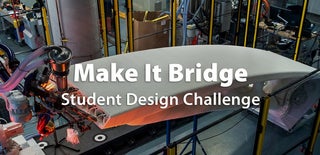Introduction: Laser Cut Austin Skyline Bridge
Hi, my name is Ava! I am a 17-year old rising senior from Austin, TX. The structure I designed for the 'Make It Bridge' Competition is a 'Bridge to Creative Expression' for Austin, TX. As someone who appreciates both art and engineering, I had a lot of fun with this project.
In this instructable I will detail the ideation, digital design, and physical fabrication process it took to build this bridge. I hope you enjoy :)
Supplies
Fusion 360
Laser Cutter
Construction material (wood, draftboard, acrylic, etc)
Wood glue
Sand paper
Step 1: Ideation
I got the inspiration for my bridge from a conversation I had recently with someone who has lived in Austin for over 60 years. We talked about Austin's rich history of counterculture, live music, and public art initiatives, all of which contributed to Austin's vibrant creative scene. This culture of creativity and quirkiness was what made Austin special. However, as Austin has grown a ton in recent decades, threats to creative expression including gentrification and rising costs, lack of affordable venues, commercialization, and limited funding/support. As a result, Austin's artsy and eccentric roots seem to be fading away.
That is why I chose to build a bridge that would re-connect Austin to its culture of creativity, inspiring artistic expression and providing a venue for anyone to create. I decided on designing the bridge with 2 key features to realize these goals:
- creative arch design with art incorporated into the structure
- the inside railing of the bridge would be made of brick for anyone to graffiti. This is a remake of the famous Austin Hope Outdoor Gallery (aka the graffiti park) that was torn down a few years ago to build condos
Step 2: Location
I decided on placing my pedestrian bridge between downtown Austin and Auditorium Shores on Town Lake.
Auditorium Shores is a popular recreational area with a large grassy field and a view of the Austin skyline. Adding a bridge here would create a connection between the park and downtown, providing rich surrounding scenery to enhance creative inspiration.
Step 3: 3D Model
Since this was my first time using Fusion 360, I decided I should start with mastering the basics: sketching. In order to practice my sketching I designed an intricate arch for the bridge that incorporates the Austin city skyline and our iconic bats. I made this sketch entirely using the line tool and spline tool (curves). For the bats and skyline, I also imported some canvases from the internet to trace.
Once I finished that sketch, I saved it as an svg to laser cut. I then extruded it and made a copy for the other bridge arch. Next, I added a panel in between the arches for pedestrians to walk across and 4 boxes to support the bridge. I also added some additional decor to make the bridge more visually appealing.
Step 4: Graffiti Wall - Canvas
I also added a canvas with an image of a brick wall to the inside railing of the bridge to represent the new graffiti wall.
Step 5: Laser Cutting + Assembly
My school luckily had some camps going on so I was able to access the maker space over the summer and use the laser cutter. If you do not have access to a laser cutter and want to try out a similar project you could try researching if your town has any maker spaces or you can cut the design out of cardboard.
As I was 3D modeling I saved my sketches as svg files. I then uploaded these svg files to the Glowforge website to laser cut. The specific steps for laser cutting will depend on what machine you have. I cut my pieces on medium draftboard.
For assembly I just used wood glue. Some pieces also needed sanding to fit together better
Step 6: Finished Bridge!

Participated in the
Make It Bridge









